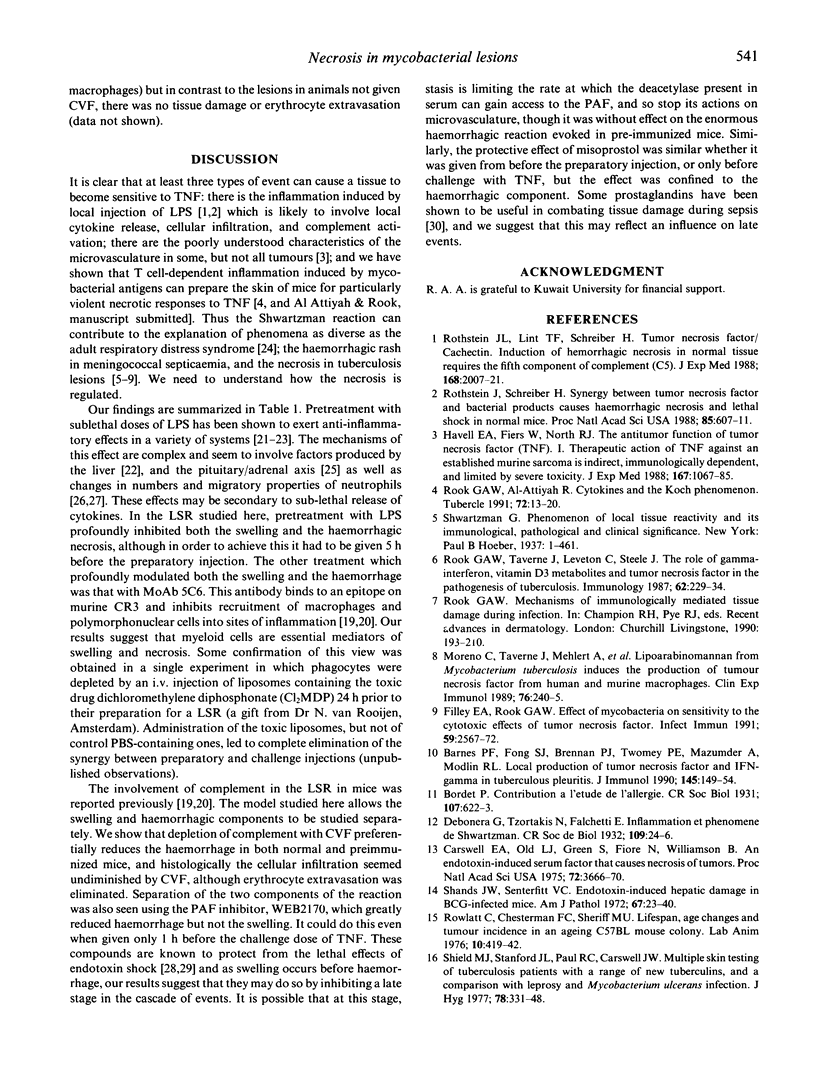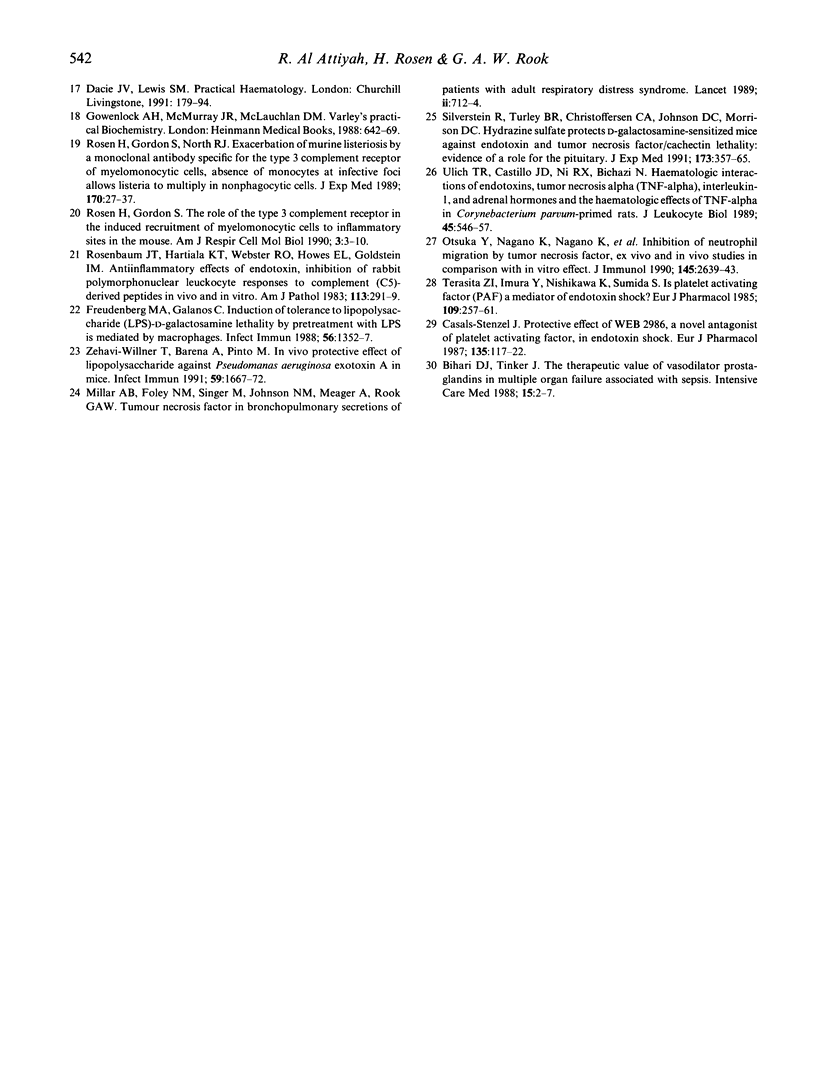Abstract
Mycobacterial lesions and skin sites challenged with soluble mycobacterial antigen are very sensitive to the necrotizing effect of tumour necrosis factor (TNF). We have used a model that permits separate quantitative assessment of swelling and haemorrhage to show that when these reactions are elicited in mice that have not been deliberately immunized, pretreatment of the mice with lipopolysaccharide (LPS), or with a MoAb to CR3 which blocks emigration of myeloid cells into the tissues, will block both the swelling and the haemorrhage. On the other hand, treatment with an inhibitor of platelet-activating factor (PAF), or with misoprostol (a synthetic prostaglandin E1 analogue), or with cobra venom factor (CVF) which depletes complement, preferentially blocks the haemorrhagic component, while leaving the swelling relatively unaltered. As swelling occurs before the haemorrhage is seen, it is possible that these factors act at a late stage in the cascade of events leading to the tissue damage. However, LPS and CVF were able to inhibit swelling and haemorrhage in the massive reactions elicited in pre-immunized animals, whereas the PAF inhibitor had no detectable effect.
Full text
PDF





Selected References
These references are in PubMed. This may not be the complete list of references from this article.
- Barnes P. F., Fong S. J., Brennan P. J., Twomey P. E., Mazumder A., Modlin R. L. Local production of tumor necrosis factor and IFN-gamma in tuberculous pleuritis. J Immunol. 1990 Jul 1;145(1):149–154. [PubMed] [Google Scholar]
- Bihari D. J., Tinker J. The therapeutic value of vasodilator prostaglandins in multiple organ failure associated with sepsis. Intensive Care Med. 1988;15(1):2–7. doi: 10.1007/BF00255627. [DOI] [PubMed] [Google Scholar]
- Carswell E. A., Old L. J., Kassel R. L., Green S., Fiore N., Williamson B. An endotoxin-induced serum factor that causes necrosis of tumors. Proc Natl Acad Sci U S A. 1975 Sep;72(9):3666–3670. doi: 10.1073/pnas.72.9.3666. [DOI] [PMC free article] [PubMed] [Google Scholar]
- Casals-Stenzel J. Protective effect of WEB 2086, a novel antagonist of platelet activating factor, in endotoxin shock. Eur J Pharmacol. 1987 Mar 17;135(2):117–122. doi: 10.1016/0014-2999(87)90602-9. [DOI] [PubMed] [Google Scholar]
- Filley E. A., Rook G. A. Effect of mycobacteria on sensitivity to the cytotoxic effects of tumor necrosis factor. Infect Immun. 1991 Aug;59(8):2567–2572. doi: 10.1128/iai.59.8.2567-2572.1991. [DOI] [PMC free article] [PubMed] [Google Scholar]
- Freudenberg M. A., Galanos C. Induction of tolerance to lipopolysaccharide (LPS)-D-galactosamine lethality by pretreatment with LPS is mediated by macrophages. Infect Immun. 1988 May;56(5):1352–1357. doi: 10.1128/iai.56.5.1352-1357.1988. [DOI] [PMC free article] [PubMed] [Google Scholar]
- Havell E. A., Fiers W., North R. J. The antitumor function of tumor necrosis factor (TNF), I. Therapeutic action of TNF against an established murine sarcoma is indirect, immunologically dependent, and limited by severe toxicity. J Exp Med. 1988 Mar 1;167(3):1067–1085. doi: 10.1084/jem.167.3.1067. [DOI] [PMC free article] [PubMed] [Google Scholar]
- Millar A. B., Foley N. M., Singer M., Johnson N. M., Meager A., Rook G. A. Tumour necrosis factor in bronchopulmonary secretions of patients with adult respiratory distress syndrome. Lancet. 1989 Sep 23;2(8665):712–714. doi: 10.1016/s0140-6736(89)90772-1. [DOI] [PubMed] [Google Scholar]
- Moreno C., Taverne J., Mehlert A., Bate C. A., Brealey R. J., Meager A., Rook G. A., Playfair J. H. Lipoarabinomannan from Mycobacterium tuberculosis induces the production of tumour necrosis factor from human and murine macrophages. Clin Exp Immunol. 1989 May;76(2):240–245. [PMC free article] [PubMed] [Google Scholar]
- Otsuka Y., Nagano K., Nagano K., Hori K., Oh-ishi J., Hayashi H., Watanabe N., Niitsu Y. Inhibition of neutrophil migration by tumor necrosis factor. Ex vivo and in vivo studies in comparison with in vitro effect. J Immunol. 1990 Oct 15;145(8):2639–2643. [PubMed] [Google Scholar]
- Rook G. A., Taverne J., Leveton C., Steele J. The role of gamma-interferon, vitamin D3 metabolites and tumour necrosis factor in the pathogenesis of tuberculosis. Immunology. 1987 Oct;62(2):229–234. [PMC free article] [PubMed] [Google Scholar]
- Rook G. A., al Attiyah R. Cytokines and the Koch phenomenon. Tubercle. 1991 Mar;72(1):13–20. doi: 10.1016/0041-3879(91)90019-o. [DOI] [PubMed] [Google Scholar]
- Rosen H., Gordon S., North R. J. Exacerbation of murine listeriosis by a monoclonal antibody specific for the type 3 complement receptor of myelomonocytic cells. Absence of monocytes at infective foci allows Listeria to multiply in nonphagocytic cells. J Exp Med. 1989 Jul 1;170(1):27–37. doi: 10.1084/jem.170.1.27. [DOI] [PMC free article] [PubMed] [Google Scholar]
- Rosen H., Gordon S. The role of the type 3 complement receptor in the induced recruitment of myelomonocytic cells to inflammatory sites in the mouse. Am J Respir Cell Mol Biol. 1990 Jul;3(1):3–10. doi: 10.1165/ajrcmb/3.1.3. [DOI] [PubMed] [Google Scholar]
- Rosenbaum J. T., Hartiala K. T., Webster R. O., Howes E. L., Jr, Goldstein I. M. Antiinflammatory effects of endotoxin. Inhibition of rabbit polymorphonuclear leukocyte responses to complement (C5)-derived peptides in vivo and in vitro. Am J Pathol. 1983 Dec;113(3):291–299. [PMC free article] [PubMed] [Google Scholar]
- Rothstein J. L., Lint T. F., Schreiber H. Tumor necrosis factor/cachectin. Induction of hemorrhagic necrosis in normal tissue requires the fifth component of complement (C5). J Exp Med. 1988 Dec 1;168(6):2007–2021. doi: 10.1084/jem.168.6.2007. [DOI] [PMC free article] [PubMed] [Google Scholar]
- Rothstein J. L., Schreiber H. Synergy between tumor necrosis factor and bacterial products causes hemorrhagic necrosis and lethal shock in normal mice. Proc Natl Acad Sci U S A. 1988 Jan;85(2):607–611. doi: 10.1073/pnas.85.2.607. [DOI] [PMC free article] [PubMed] [Google Scholar]
- Rowlatt C., Chesterman F. C., Sheriff M. U. Lifespan, age changes and tumour incidence in an ageing C57BL mouse colony. Lab Anim. 1976 Oct;10(10):419–442. doi: 10.1258/002367776780956917. [DOI] [PubMed] [Google Scholar]
- Shands J. W., Jr, Senterfitt V. C. Endotoxin-induced hepatic damage in BCG-infected mice. Am J Pathol. 1972 Apr;67(1):23–40. [PMC free article] [PubMed] [Google Scholar]
- Shield M. J., Stanford J. L., Paul R. C., Carswell J. W. Multiple skin testing of tuberculosis patients with a range of new tuberculins, and a comparison with leprosy and Mycobacterium ulcerans infection. J Hyg (Lond) 1977 Jun;78(3):331–348. doi: 10.1017/s0022172400056230. [DOI] [PMC free article] [PubMed] [Google Scholar]
- Silverstein R., Turley B. R., Christoffersen C. A., Johnson D. C., Morrison D. C. Hydrazine sulfate protects D-galactosamine-sensitized mice against endotoxin and tumor necrosis factor/cachectin lethality: evidence of a role for the pituitary. J Exp Med. 1991 Feb 1;173(2):357–365. doi: 10.1084/jem.173.2.357. [DOI] [PMC free article] [PubMed] [Google Scholar]
- Terashita Z., Imura Y., Nishikawa K., Sumida S. Is platelet activating factor (PAF) a mediator of endotoxin shock? Eur J Pharmacol. 1985 Feb 26;109(2):257–261. doi: 10.1016/0014-2999(85)90427-3. [DOI] [PubMed] [Google Scholar]
- Ulich T. R., del Castillo J., Ni R. X., Bikhazi N. Hematologic interactions of endotoxin, tumor necrosis factor alpha (TNF alpha), interleukin 1, and adrenal hormones and the hematologic effects of TNF alpha in Corynebacterium parvum-primed rats. J Leukoc Biol. 1989 Jun;45(6):546–557. doi: 10.1002/jlb.45.6.546. [DOI] [PubMed] [Google Scholar]
- Zehavi-Willner T., Barnea A., Pinto M. In vivo protective effect of lipopolysaccharide against Pseudomonas aeruginosa exotoxin A in mice. Infect Immun. 1991 May;59(5):1667–1672. doi: 10.1128/iai.59.5.1667-1672.1991. [DOI] [PMC free article] [PubMed] [Google Scholar]


